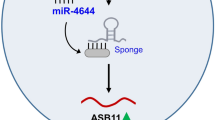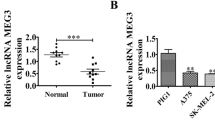Abstract
Melanoma ranks second in aggressive tumors, and the occurrence of metastasis in melanoma results in a persistent drop in the survival rate of patients. Therefore, it is very necessary to find a novel therapeutic method for treating melanoma. It has been reported that lncRNA XIST could promote the tumorigenesis of melanoma. However, the mechanism by which lncRNA XIST regulates the progression of melanoma remains unclear. The proliferation of A375 cells was measured by clonal formation. Cell viability was detected by MTT assay. Flow cytometry was performed to detect cell apoptosis and cycle. The level of GINS2, miR-23a-3p, and lncRNA XIST was investigated by qRT-PCR. Protein level was detected by Western blot, and the correctness of prediction results was confirmed by Dual luciferase. In present study, GINS2 and lncRNA XIST were overexpressed in melanoma, while miR-23a-3p was downregulated. Silencing of GINS2 or overexpression of miR-23a-3p reversed cell growth and promoted apoptosis in A375 cells. Mechanically, miR-23a-3p directly targeted GINS2, and XIST regulated GINS2 level though mediated miR-23a-3p. Moreover, XIST exerted its function on cell proliferation, cell viability, and promoted the cell apoptosis of A375 cells though miR-23a-3p/GINS2 axis. LncRNA XIST significantly promoted the tumorigenesis of melanoma via sponging miR-23a-3p and indirectly targeting GINS2, which can be a potential new target for treating melanoma.






Similar content being viewed by others
Data availability
All data generated or analyzed during this study are included in this published article.
References
GershenwaldScolyer JERA, HessSondakLongRoss KRVKGVMI et al (2017) Melanoma staging: evidence-based changes in the American Joint Committee on cancer eighth edition cancer staging manual. CA Cancer J Clin 67(6):472–492
Fischer GM, Vashisht Gopal YN, McQuade JL, Peng W, DeBerardinis RJ, Davies MA (2018) Metabolic strategies of melanoma cells: mechanisms, interactions with the tumor microenvironment, and therapeutic implications. Pigment Cell Melanoma Res 31(1):11–30
Chattopadhyay C, Kim DW, Gombos DS, Oba J, Qin Y, Williams MD et al (2016) Uveal melanoma: from diagnosis to treatment and the science in between. Cancer 122(15):2299–2312
Scolyer RA, Judge MJ, Evans A, Frishberg DP, Prieto VG, Thompson JF et al (2013) Data set for pathology reporting of cutaneous invasive melanoma: recommendations from the international collaboration on cancer reporting (ICCR). Am J Surg Pathol 37(12):1797–1814
Xu J, Bai J, Zhang X, Lv Y, Gong Y, Liu L et al (2017) A comprehensive overview of lncRNA annotation resources. Brief Bioinform 18(2):236–249
Jia H, Wang X, Sun Z (2020) Exploring the long noncoding RNAs-based biomarkers and pathogenesis of malignant transformation from dysplasia to oral squamous cell carcinoma by bioinformatics method. Eur J Cancer Prev. https://doi.org/10.1097/CEJ.0000000000000527
Teng L, Meng R (2019) Long non-coding RNA MALAT1 promotes acute cerebral infarction through miRNAs-mediated hs-CRP regulation. J Mol Neurosci. https://doi.org/10.1007/s12031-019-01384-y
An T, Zhang J, Ma Y, Lian J, Wu YX, Lv BH et al (2019) Relationships of non-coding RNA with diabetes and depression. Sci Rep 9(1):10707
Chen DL, Chen LZ, Lu YX, Zhang DS, Zeng ZL, Pan ZZ et al (2017) Long noncoding RNA XIST expedites metastasis and modulates epithelial-mesenchymal transition in colorectal cancer. Cell Death Dis 8(8):e3011
Sun J, Pan LM, Chen LB, Wang Y (2017) LncRNA XIST promotes human lung adenocarcinoma cells to cisplatin resistance via let-7i/BAG-1 axis. Cell Cycle 16(21):2100–2107
Shoeibi S (2019) Diagnostic and theranostic microRNAs in the pathogenesis of atherosclerosis. Acta Physiol 228(1):e13353
Liao HQ, Liu H, Sun HL, Xiang JB, Wang XX, Jiang CX et al (2019) MiR-361–3p/Nfat5 signaling axis controls cementoblast differentiation. J Dent Res. https://doi.org/10.1177/0022034519864519
Kamrani A, Alipourfard I, Ahmadi-Khiavi H, Yousefi M, Rostamzadeh D, Izadi M et al (2019) The role of epigenetic changes in preeclampsia. BioFactors. https://doi.org/10.1002/biof.1542
Jiang L, Bi DH, Ren Q, Wang P, Kan X (2019) Identification and comparative profiling of gonadal microRNAs in the adult pigeon (Columba livia). Br Poult Sci. https://doi.org/10.1080/00071668.2019.1639140
Grieco FA, Sebastiani G, Juan-Mateu J, Villate O, Marroqui L, Ladriere L et al (2017) MicroRNAs miR-23a-3p, miR-23b-3p, and miR-149-5p regulate the expression of proapoptotic BH3-only proteins DP5 and PUMA in human pancreatic beta-cells. Diabetes 66(1):100–112
Choi SH, Ryu S, Sim K, Song C, Shin I, Kim SS et al (2020) Anti-glioma effects of 2-aminothiophene-3-carboxamide derivatives, ANO1 channel blockers. Eur J Med Chem 208:112688
Qian S, Fang H, Zheng L, Liu M (2020) Zingerone suppresses cell proliferation via inducing cellular apoptosis and inhibition of the PI3K/AKT/mTOR signaling pathway in human prostate cancer PC-3 cells. J Biochem Mol Toxicol 9:e22611. https://doi.org/10.1002/jbt.22611
Pavri SN, Clune J, Ariyan S, Narayan D (2016) Malignant melanoma: beyond the basics. Plast Reconstr Surg 138(2):e330–e340
Byers RM, Smith JL, Russell N, Rosenberg V (1980) Malignant melanoma of the external ear. Review of 102 cases. Am J Surg. 140(4):518–521
Topalian SL, Hodi FS, Brahmer JR, Gettinger SN, Smith DC, McDermott DF et al (2019) Five-year survival and correlates among patients with advanced melanoma, renal cell carcinoma, or non-small cell lung cancer treated with nivolumab. JAMA Oncol. https://doi.org/10.1001/jamaoncol.2019.2187
Valdeira ASC, Darvishi E, Woldemichael GM, Beutler JA, Gustafson KR, Salvador JAR (2019) Madecassic acid derivatives as potential anticancer agents: synthesis and cytotoxic evaluation. J Nat Prod. https://doi.org/10.1021/acs.jnatprod.8b00864
Sutton SK, Cheung BB, Massudi H, Tan O, Koach J, Mayoh C et al (2019) Heterozygous loss of keratinocyte TRIM16 expression increases melanocytic cell lesions and lymph node metastasis. J Cancer Res Clin Oncol. https://doi.org/10.1007/s00432-019-02981-5
Scull CE, Zhang Y, Tower N, Rasmussen L, Padmalayam I, Hunter R et al (2019) Discovery of novel inhibitors of ribosome biogenesis by innovative high throughput screening strategies. Biochem J. https://doi.org/10.1042/BCJ20190207
Liu C, Wang R, Zhang Y (2019) GINS complex subunit 2 (GINS2) plays a protective role in alcohol-induced brain injury. Artif Cells Nanomed Biotechnol 47(1):1–9
Liu X, Sun L, Zhang S, Zhang S, Li W (2019) GINS2 facilitates epithelial-to-mesenchymal transition in non-small-cell lung cancer through modulating PI3K/Akt and MEK/ERK signaling. J Cell Physiol. https://doi.org/10.1002/jcp.29381
Shen YL, Li HZ, Hu YW, Zheng L, Wang Q (2019) Loss of GINS2 inhibits cell proliferation and tumorigenesis in human gliomas. CNS Neurosci Ther 25(2):273–287
Ye Y, Song YN, He SF, Zhuang JH, Wang GY, Xia W (2019) GINS2 promotes cell proliferation and inhibits cell apoptosis in thyroid cancer by regulating CITED2 and LOXL2. Cancer Gene Ther 26(3–4):103–113
Guo Z, Zhou C, Zhong X, Shi J, Wu Z, Tang K et al (2019) The long noncoding RNA CTA-941F9.9 is frequently downregulated and may serve as a biomarker for carcinogenesis in colorectal cancer. J Clin Lab Anal 33(9):e22986
Ma J, Yan H, Zhang J, Tan Y, Gu W (2019) Long-chain non-coding RNA (lncRNA) MT1JP suppresses biological activities of lung cancer by regulating miRNA-423-3p/Bim Axis. Med Sci Monit 25:5114–5126
Ferre F, Colantoni A, Helmer-Citterich M (2016) Revealing protein-lncRNA interaction. Brief Bioinform 17(1):106–116
Backes C, Meese E, Keller A (2016) Specific miRNA disease biomarkers in blood, serum and plasma: challenges and prospects. Mol Diagn Ther 20(6):509–518
Paraskevopoulou MD, Hatzigeorgiou AG (2016) Analyzing miRNA-LncRNA interactions. Methods Mol Biol 1402:271–286
Ballantyne MD, McDonald RA, Baker AH (2016) lncRNA/microRNA interactions in the vasculature. Clin Pharmacol Ther 99(5):494–501
Ma M, Dai J, Tang H, Xu T, Yu S, Si L et al (2019) MicroRNA-23a-3p inhibits mucosal melanoma growth and progression through targeting adenylate cyclase 1 and attenuating cAMP and MAPK pathways. Theranostics 9(4):945–960
Liu J, Fan L, Yu H, Zhang J, He Y, Feng D et al (2019) Endoplasmic reticulum stress causes liver cancer cells to release exosomal miR-23a-3p and up-regulate programmed death ligand 1 expression in macrophages. Hepatology 70(1):241–258
Wei W, Liu Y, Lu Y, Yang B, Tang L (2017) LncRNA XIST Promotes pancreatic cancer proliferation through miR-133a/EGFR. J Cell Biochem 118(10):3349–3358
Sun W, Zu Y, Fu X, Deng Y (2017) Knockdown of lncRNA-XIST enhances the chemosensitivity of NSCLC cells via suppression of autophagy. Oncol Rep 38(6):3347–3354
Chen K, Ma Y, Wu S, Zhuang Y, Liu X, Lv L et al (2019) Construction and analysis of a lncRNAmiRNAmRNA network based on competitive endogenous RNA reveals functional lncRNAs in diabetic cardiomyopathy. Mol Med Rep 20(2):1393–1403
Shen J, Hong L, Yu D, Cao T, Zhou Z, He S (2019) LncRNA XIST promotes pancreatic cancer migration, invasion and EMT by sponging miR-429 to modulate ZEB1 expression. Int J Biochem Cell Biol 113:17–26
Funding
This work was supported by 2019 Inner Mongolia Autonomous Region Natural Science Foundation project “Experimental research on the treatment of malignant melanoma by RNA interference technology targeting GINS2 (No.2019MS08041)”.
Author information
Authors and Affiliations
Contributions
Z-HL and Y-QH designed the work. S-XK, KZ, K-WL, and XZ analyzed the data. LL drafted the work. Z-HL, K-WL, and WH revised the manuscript. All authors approved the manuscript to be published.
Corresponding author
Ethics declarations
Conflict of interest
These authors declare no competing interests in this study.
Ethical approval
Ethical approval was obtained from the ethics committee of the Third Affiliated Hospital of Inner Mongolia Medical University and informed written consent was obtained from all patients.
Informed consent
The informed consent obtained from study participants.
Additional information
Publisher's Note
Springer Nature remains neutral with regard to jurisdictional claims in published maps and institutional affiliations.
Rights and permissions
About this article
Cite this article
Hao, YQ., Liu, KW., Zhang, X. et al. GINS2 was regulated by lncRNA XIST/miR-23a-3p to mediate proliferation and apoptosis in A375 cells. Mol Cell Biochem 476, 1455–1465 (2021). https://doi.org/10.1007/s11010-020-04007-y
Received:
Accepted:
Published:
Issue Date:
DOI: https://doi.org/10.1007/s11010-020-04007-y




